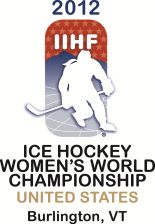ZURICH – After their sixth-place finish on home ice last year, the Swiss women’s national team aims to maintain its place in the top division, but is also hoping for more in Burlington.
Hosting the IIHF Ice Hockey Women’s World Championship in Zurich and Winterthur last year was seen as a way to promote women’s hockey, in a country where women playing the sport long seemed to be tolerated rather than encouraged in many parts of the country.
But the signs in the short-term don’t look overwhelmingly positive. On home ice the Swiss lost fifth place in the Women’s World Ranking to Russia. Only six teams receive a bye to the 2014 Sochi Olympics. However, the advantage to seventh-ranked Slovakia is 65 points and the danger of losing sixth place is marginal. The Slovaks, also an underdog, would need to end up three or four places better than the Swiss in Burlington to overtake their rival.
Having said that, the Swiss women’s hockey program has suffered setbacks at junior level. The U18 team was again demoted back to Division I. The Swiss also had to decline sending a girls’ team to the Winter Youth Olympic Games because they didn’t have enough girls born in 1994 to form a team.
However, on the club level Switzerland celebrated its biggest success ever in women’s hockey history in February when the ZSC Lions Zurich won the silver medals at the European Women’s Champions Cup. They beat opponents from Finland and Germany in the final tournament, but lost to eventual EWCC winner Tornado Moscow Region that is run as a professional team opposed to the other participants.
“The tournament was very important for us and it was cool to win silver,” says forward Katrin Nabholz. “We knew that we could make it, but you still need to do it first. It was a great experience for us to win silver and defeat the Finns.”
Opposed to Tornado Moscow, club teams in Switzerland don’t practise every day and all players either work or study, like Nabholz, who studies veterinary medicine.
“We noticed that they practise every day,” Nabholz says. “They were physically stronger than us, but I think in other aspects such as skills and tactics we were at the same level.”
Some weeks later the lionesses added another medal when they defended the Swiss championship.
Nabholz is what you could call a typical product of Swiss women’s hockey. Until she was 16 she played with youth teams of EHC Basel before leaving her native city to find a top team in the women’s league.
There it usually ends up with the ZSC Lions vs. HC Lugano playing for gold as these two clubs seem to be the most successful ones in attracting players.
After Lugano had dominated the Swiss league for a couple of years, it’s the Zurich team that was crowned champion twice in a row.
“Women’s hockey in Switzerland is improving year by year, and step by step,” says Nabholz. “Little girls are joining the sport, but right now we don’t have enough players. We’re lacking in depth.”
“Media could write more about women’s hockey. Most people don’t even know that women’s hockey exists. When girls think what sport they could play, they don’t necessarily think about hockey because they don’t know it. Most players started to play because their brothers did so.”
Like Nabholz, whose mother was fascinated by the sport and who joined her brothers to the rink.
The national team going to Burlington mostly consists of players active in Switzerland, either in the women’s league or the younger ones with boys’ teams where they can develop at a more intense level of play.
Two players join from Germany and three from U.S. colleges with the Waidacher sisters Monika and Nina, and netminder Florence Schelling.
Schelling’s performance can be a deciding factor for the Swiss. In her final year with the Northeastern University, she was among the three finalists for the Patty Kazmaier Memorial Award given annually to the best NCAA women’s hockey player. Having the best goaltender in U.S. college hockey on the team surely won’t hurt an underdog squad.
In 2008 in Harbin, China, when the Swiss had one of their best performances of the recent years, Schelling was one of the main reasons Switzerland was able to upset Sweden for a fourth-place finish.
But fourth place is right now far away for the Swiss who start in Group B with the teams seeded 5th-8th.
“Our main target is to maintain in the top division,” she says. “We had ups and downs this season. At the beginning we didn’t play very well, but after Christmas it went better. We had some players back and saw our potential.”
“I take it step by step. First we have to secure our spot in the top division by playing a good preliminary round and then we’ll see what is possible.”
MARTIN MERK
|







